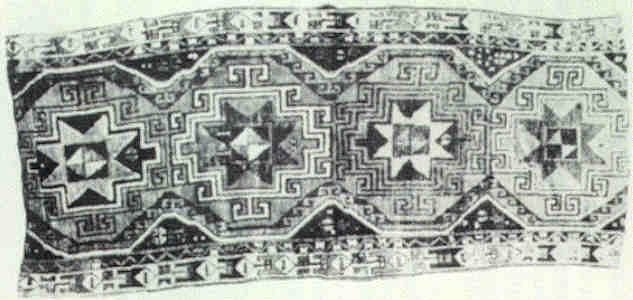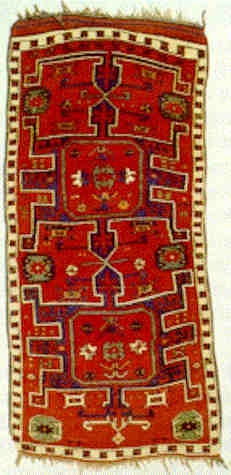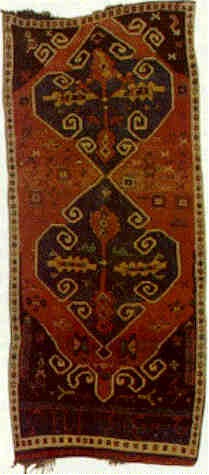The
Emergence of a Kurdish Rug Type
by William Eagleton
Oriental Rug Review, Vol. 9, No.
5
For most of us a rug type exists only after it
has reached international markets and has been seen and classified by collectors
and scholars. Until then rugs and other weavings can be present in considerable
numbers in their natural habitats without attracting the attention of the
outside world. This was the case with many Anatolian, Iranian, and Iraqi kilims,
bags, and trappings 20 years ago; however, it seemed unlikely that by 1988 any
major rug type was still awaiting discovery. Nevertheless, such a weaving has
recently emerged from the Kurdish heartland of Eastern Turkey.
|

|
This is not to say that these rugs were
never seen or recorded in print before. An
article by Anthony Landreau in The Textile
Museum Journal of December, 1973, provided a
black-and-white photograph of such a rug in the
hands of Kurdish villagers in the mountains of
the Turkish Hakkari region south of Lake Van.
Because the appearance of these large, heavy
Kurdish rugs in the market coincided with my own
research for a book on Kurdish weavings, I will
recount the story as it unfolded for me.
I first saw this Kurdish type in a badly
used-up condition in the suq in Mosul, Iraq, in
1981. It was blue, red, white and brown, and its
design was one of the two most common types,
available (Illustration 1). It was obviously not
related to the Kurdish rugs of northern Iraq,
and therefore I suspected that when the dealer
said it came from "the North" he meant Turkey.
I did not see another such rug until 1983,
even though during the period I covered the
major rug centers of central and eastern Turkey
looking for Kurdish weavings. Hence, it was
something of a shock when, in 1983, in an
obscure furniture shop in Mardin, there appeared
a pile of about 10 of these rugs in a variety of
designs, some in clear, bold colors, unlike
those of the neighboring Iraqi and Turkish Herki
and related tribal rugs. After the usual debate
on prices, I acquired four pieces, three of
which are illustrated in the Turkish section of
Kurdish Rugs. When I asked the vendor
where they came from, I did not take seriously
his familiar reply, "over near the
Russian-Caucasian border." Looking for something
more authoritative, I sent photographs to Burhan
Kartal, a friend and rug dealer in Van, even
though these rugs were not then available in the
several Van rug shops (there are now over 40).
Mr. Kartal replied that his investigation
indicated they were woven in the southern part
of the Hakkari mountains by the Goyan tribe, and
it is under this name that I classified them in
Kurdish Rugs.
|
Illustration 1. Hartushi common type
Later research has revealed that the rugs were
woven by all of the 11 sections of the large Hartushi tribe, of which the Goyan
were originally a part. Hence the preferred label for these is now Hartushi;
but, if you are looking for one in Istanbul or Konya, you will find that they
are usually referred to as "Herkis." This is a classic example of how a rug type
comes to be mislabeled by the trade. Turkish dealers have long known, and
carried in their inventories, rugs from the Van region labeled "Herki" after the
large nomadic Herki and associated tribes which, until recently, moved back and
forth within the frontier area of Iraq, Iran, and Turkey. The Herki rugs,
however, are quite different in dyes, design, size and structure. The Herkis
(Illustration 2) are almost all in the roughly one meter by two meter format,
while the Hartushis are 125 to 160 centimeters wide and two-and-a-half to three
and-a-half meters long, with some even larger sizes available. By chance, two of
the rugs I found in the Mardin furniture shop were in a narrower runner format,
but this appears to be atypical.
|

|
Illustration 2. Hertki, c. 1940
Technical Analysis
Warp: Orange wool
Weft: Dark brown goat hair, two shoots
Knot: 5x7, 35 per square inch
Colors: BURGUNDY, blue, orange, brown, pink,
pink, white, yellow, plum
Size: 81"x41"
Edge: Sides: selvages overcast with pile wool,
color bands
Bottom: 4" kilim, four twinings
Top; round 9" plaits every 2" to v braids to 4"
kilim
|
As can be seen in the illustration, the Herki
rugs have rather complicated designs, either original or borrowed, and the
fields are usually adorned with a variety of small devices that are typical of
the tribal Kurdish repertoire. Most Hartushis, however, have small borders and
large dramatic medallion type centers repeated in twos, threes, fours, or fives,
or fractions thereof. The fields are relatively uncluttered.
Back to the process of discovery: it was not
until September, 1987, in a stopover in Istanbul that I saw two of these rugs in
a repair shop on the edge of the Istanbul bazaar. I asked a friend to try to
find others, but it was some months later that I discovered that, if I had
looked in the right places, I could have seen hundreds in Istanbul.
The next step was a visit a few months later
to Konya where Hakan Tazecan, knowing of my interest in Kurdish rugs, told me he
had just bought 35 Herkis. Would I like to see them? The prospect of seeing
Herkis after four years in Iraq where they were available in large numbers did
not excite me; but, when he displayed-his "Herkis," I realized he was in
possession of a hoard of what we now call Hartushis. Shortly thereafter, similar
hoards were found in Istanbul.
The mystery, however, had not yet been cleared
up. Why had these rugs not been seen in the market before, and why had they
suddenly appeared in such large numbers? All agreed that pickers were bringing
them in unwashed from the East by the truckload and peddling them in the
Istanbul and West Anatolian rug markets. Initially, the rugs were not as popular
with dealers as they might be with collectors since they are very heavy, require
considerable space, and are hard to manage, both by the boys who lay them out
and by the repair crews. Despite full, fleecy piles, many of them have holes or
other defects when they are collected from villages, and these must be corrected
before they are salable. Some of them are deemed non-commercial because of the
prominent use of bright orange or pink. In Turkey this can be remedied at little
expense by substituting more acceptable yarns.
We have not yet had an opportunity to submit
the fibers of these rugs for dye analyses. Many of the dyes, particularly in the
later examples, are probably chemical, including certainly the pinks and the
bright oranges. It is remarkable, however, that they rarely run with washing,
although in 'some rugs the reds of a certain period (perhaps 40 to 60 years ago)
have faded to abrashed light red. Many colors, however, remain vivid. The blues,
blue-greens, yellows, and browns, and most reds are impressive. The overall
effect is reminiscent of some of the crude, but much appreciated, Caucasian rugs
of the late 19th and early 20th centuries.
Most Hartushi rug designs are native to the
Kurdish Eastern Anatolian-Caucasian area, though an occasional piece is
influenced by other Turkish weaving. The execution, however, is from the mind,
or possibly from another rug, but not from a detailed drawing. Inquiries during
our investigation in the Van region in June, 1988, led to the conclusion that
the Hartushi rug designs, like the Hartushi (Van) kilim designs, are woven
interchangeably by all sections of the large Hartushi tribe. Hence, there is no
way to assign designs to specific sections of the tribe. The major rug designs
bear little resemblance to the repeat designs found in the Hartushi kilims. We
have found this to be the rule with other Kurdish tribal weavings as well. The
only exceptions are some of the simple borders where there may be similarities
between the kilims and the rugs.
|

|
Illustration 3. Hartushi with "Caucasian" turtle,
c. 1930
Technical Analysis
Warp: white, black, brown goat hair, and mohair
Weft: Tan wool, three shoots
Knot: 4x5
Colors: RED, blue, blue-green, purple, orange,
white Size: 104"x49"
Edge: w - 3 blue selvages
Ends: 4" plaits to 1" crossbraid
|
The most persistent and notable field design
is a shield which is referred to as a "turtle" in Kurdish and Turkish. It is
found on about 20% of the Hartushi rugs. This dramatic device is seen in
weavings from the Iranian and (allegedly) Soviet Azerbaijans. It is hard to
believe that it developed from urban influence or was originally conceived to
represent a turtle. It is best known to the rug world from soumack bagfaces
attributed to the Caucasus, one of which appeared on the cover of the 1969
Textile Museum publication, From the Bosphorus to Samarkand, Flat Woven Rugs.
Others recently seen at auctions are not only similar to those found in
Hartushi rugs but are, in fact, identical in at least one case (Illustration 3,
pg. 24), including minor field devices. Perhaps we should reexamine the claimed
Caucasian parentage of the soumak bagfaces, though it is not suggested here that
they are necessarily produced by the Hartushis. For those who favor antique
origins, geometric human figures with arms held out and up can be found on
artifacts from the period 1300 to 800 B.C. attributed to Anatolian peoples,
including Hittites. In addition to the "turtle" (Illustration 3) and a variety
of Memling guls (Illustration 1), eight-pointed stars are common, both as major
field designs and as adornments. In fact, the centers of most "turtles" contain
large, eight-pointed stars.
|
The structures of the Hartushis are quite
uniform. A typical rug would be eight to l2 feet
long and four feet wide with tan or grey wool or
goat hair warps and with wool wefts in natural
or sometimes dyed pile wool. The wool is hard,
strong, and sometimes shiny, lying at an angle
because of the multiple wefts. Although north of
Lake Van the brown sheep influence the color
scheme of the Kars rugs and kilims, the Hakkari
region to the south of the lake has many white
sheep whose wool is available for the pile and
takes the dyes well.
Knots are large and the count is typically
four-by-four or four-by-five per inch. Between
each row of knots there are usually three to
four wefts. The sides usually have thick
selvages either in two bunches with a
figure-eight wrapping or sometimes in flatter,
smaller selvages of three or four bunches. Some
of the selvages have color changes down the
sides. The ends are typically six-inch plaits
connected to a one-inch cross braid and then a
one inch or shorter kilim leading to the pile.
A novel structure in many Hartushi rugs is a
triangular add-on at one or both ends. The
Hartushis share in a large way the Kurdish trait
of turning out rugs in irregular shapes. In the
Hartushis, when the end is pulled tighter at the
sides creating a rounded effect, triangular
wedges are sometimes added from leftover pile
yarn to straighten the end (Illustration 4, pg.
22).
The age of these rugs is not readily
apparent. Few are dated, but the most recent
date we have found is 1973. The earliest,
probably authentic date is 1915 (Illustration
5). A number of the rugs appear to be earlier
than this rug, so we can tentatively conclude
that, while most were woven between 10 and 60
years ago, some were woven in the last century.
As far as we are able to determine,
virtually no Hartushi rugs are now being
produced. Instead, weavers are turning out
smaller lightweight fabrics for the tourist
trade. Then, why are these rugs now on the
market when they were unavailable only a few
years ago?
|
Illustration 4, Hartushi backs, some showing
triangular add-ons
This is a question we put to a number of
people in the Van-Hakkari region during a trip to eastern Turkey in June, 1988.
The most common answer was, "Only recently did the pickers get into the villages
to bring the rugs out," but this is, of course, an incomplete answer. It has
been suggested that political developments in the region might have had an
effect, and indeed some sources claim that rugs have been brought out of
villages in northern Iraq near the Turkish border wherethere have been movements
of people from Iraqi Kurdish villages to resettlement areas. The best
explanation, it seems, is that those who own the rugs no longer prize them as
highly as they do cash or new machine-made rugs which are given in exchange, and
once the process got underway, the profit motive takes the pickers deeper into
the mountains in search of more and more rugs.
It is not at all certain how many Hartushi
rugs will be available for the many collectors who are looking for tribal rugs
untouched by urban or commercial influences. If for several years there is a
glut, this does not mean that they are inexhaustible. Tens of thousands of Jaf
bags flooded the U. S. market in the 1 920s and '30s, but they are now rare
where they originated in Iran and Iraq. There are probably 300 to 500 Hartushi
rugs now in the retail and wholesale outlets of Istanbul, and several hundred
more in the other centers of Turkey. Perhaps a thousand or two still remain to
be brought, out of the mountains. It can be a risky business going into these
villages unless the picker has somehow gained the confidence of the tribesmen
and women. However, greed will win out and, before long, most of the Hartushi
rugs will have been extracted, and many of them will be in Europe and the United
States. During the past few months prices have risen, perhaps indicating that
supplies are drying up -- or that demand is increasing.
It is likely that enough of these rugs will
soon be available to form a group that will find its place in the rug
vocabulary. When this happens, let us begin by discarding the "Herki" label and
calling the rugs after their tribal origin, "Hartushis," or if attribution to
the area rather than the tribe is preferred, "Hakkaris."
|

|
Illustration 5. Dated Hartushi, 1915
Technical Analysis Warp: brown and white goat hair
Weft: Tan wool, two-ply
Knot: 4 1/2x4
Colors: MEDIUM BLUE, red, brown, yellow, white,
blue-green
Size: 110"x47"
Bottom: Short plaits found at the ends in pairs
to 1" crossbraid
Top: s
|



